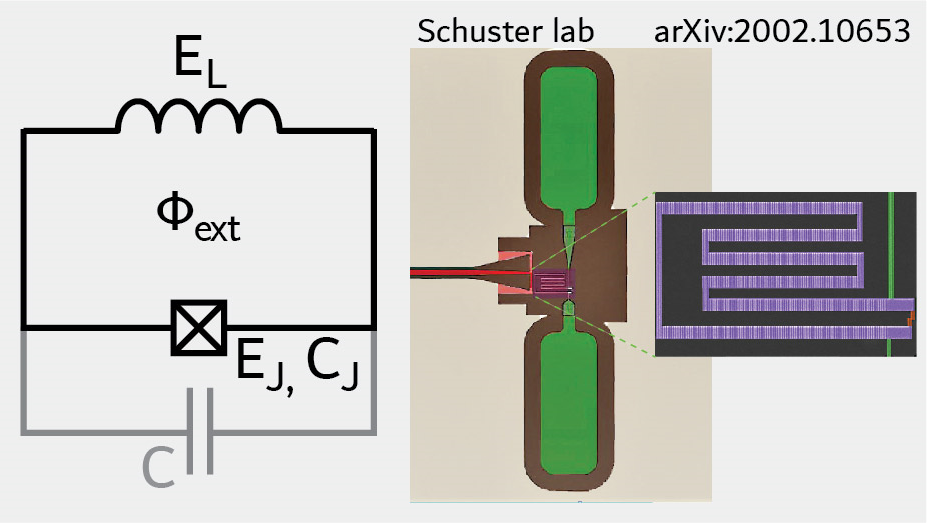Fluxonium#

The Hamiltonian of the fluxonium qubit [Manucharyan2009] in phase basis representation is given by
Here, \(E_C\) is the charging energy, \(E_J\) the Josephson energy, \(E_L\) the inductive energy, and
\(\varphi_\text{ext}=2\pi \Phi_\text{ext}/\Phi_0\) the external flux in dimensionless form. The Fluxonium class
internally uses the \(E_C\)-\(E_L\) harmonic-oscillator basis [Zhu2013] with truncation level specified by cutoff.
An instance of the fluxonium qubit is created as follows:
fluxonium = scqubits.Fluxonium(EJ = 8.9,
EC = 2.5,
EL = 0.5,
flux = 0.33,
cutoff = 110)
Here, the flux threading the circuit loop is specified by flux which records the flux in units of the magnetic
flux quantum, \(\Phi_\text{ext}/\Phi_0\).
From within a Jupyter notebook, a fluxonium instance can alternatively be created with:
fluxonium = scqubits.Fluxonium.create()
This functionality is enabled if the ipywidgets package is installed, and displays GUI forms prompting for
the entry of the required parameters.
Wavefunctions and visualization of eigenstates#
|
Returns a fluxonium wave function in phi basis |
Plot 1d phase-basis wave function(s). |
Implemented operators#
The following operators are implemented for use in matrix element calculations.
|
Returns the \(n = - i d/d\phi\) operator in the LC harmonic oscillator or eigenenergy basis. |
|
Returns the phi operator in the LC harmonic oscillator or eigenenergy basis. |
Returns the \(e^{i (\alpha \phi + \beta) }\) operator, with \(\alpha\) and \(\beta\) being numbers, in the LC harmonic oscillator or eigenenergy basis. |
|
|
Returns the \(\cos (\alpha \phi + \beta)\) operator with \(\alpha\) and \(\beta\) being numbers, in the LC harmonic oscillator or eigenenergy basis. |
|
Returns the \(\sin (\alpha \phi + \beta)\) operator with \(\alpha\) and \(\beta\) being numbers, in the LC harmonic oscillator or eigenenergy basis. |
Computation and visualization of matrix elements#
|
Returns table of matrix elements for operator with respect to the eigenstates of the qubit. |
|
Plots matrix elements for operator, given as a string referring to a class method that returns an operator matrix. |
Calculates matrix elements for a varying system parameter, given an array of parameter values. |
|
Generates a simple plot of a set of eigenvalues as a function of one parameter. |
Estimation of coherence times#
Show plots of coherence for various channels supported by the qubit as they vary as a function of a changing parameter. |
|
Plot effective \(T_1\) coherence time (rate) as a function of changing parameter. |
|
Plot effective \(T_2\) coherence time (rate) as a function of changing parameter. |
|
|
Calculate the transition time (or rate) using Fermi's Golden Rule due to a noise channel with a spectral density spectral_density and system noise operator noise_op. |
|
\(T_1\) due to dielectric dissipation in the Josephson junction capacitances. |
|
Noise due to charge coupling to an impedance (such as a transmission line). |
Calculate the effective \(T_1\) time (or rate). |
|
|
Noise due to a bias flux line. |
|
\(T_1\) due to inductive dissipation in a superinductor. |
Noise due to quasiparticle tunneling across a Josephson junction. |
|
Calculate the effective \(T_2\) time (or rate). |
|
|
Calculate the 1/f dephasing time (or rate) due to arbitrary noise source. |
Calculate the 1/f dephasing time (or rate) due to critical current noise. |
|
Calculate the 1/f dephasing time (or rate) due to flux noise. |